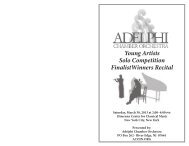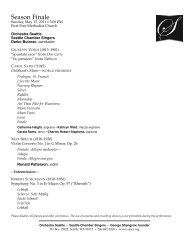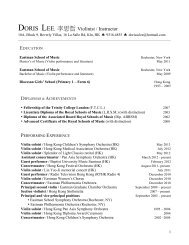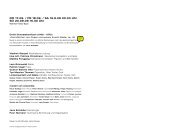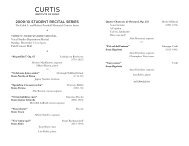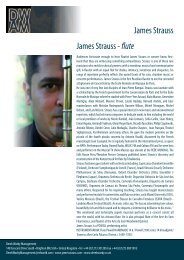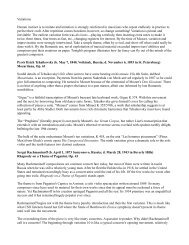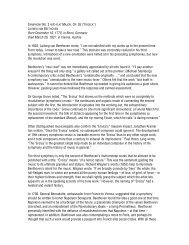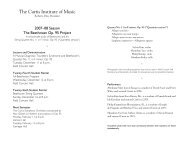Born May 7, 1833, in Hamburg, Germany Died April ... - InstantEncore
Born May 7, 1833, in Hamburg, Germany Died April ... - InstantEncore
Born May 7, 1833, in Hamburg, Germany Died April ... - InstantEncore
Create successful ePaper yourself
Turn your PDF publications into a flip-book with our unique Google optimized e-Paper software.
CONCERTO IN D MINOR FOR VIOLIN AND ORCHESTRA, OP. 77<br />
JOHANNES BRAHMS<br />
<strong>Born</strong> <strong>May</strong> 7, <strong>1833</strong>, <strong>in</strong> <strong>Hamburg</strong>, <strong>Germany</strong><br />
<strong>Died</strong> <strong>April</strong> 3, 1897, <strong>in</strong> Vienna, Austria<br />
“One enjoys gett<strong>in</strong>g hot f<strong>in</strong>gers play<strong>in</strong>g it, because it’s worth it!”<br />
– Joseph Joachim<br />
In 1878, Johannes Brahms summered <strong>in</strong> Portschach <strong>in</strong> southern Austria, where he had completed<br />
his second symphony one year prior. The lakeside was fruitful for him, and this year, he worked<br />
dur<strong>in</strong>g the summer and early fall on his Viol<strong>in</strong> Concerto. In August, he wrote to his friend, viol<strong>in</strong>ist<br />
Joseph Joachim, “After copy<strong>in</strong>g it, I am not sure what you can do with a mere solo part. Of course,<br />
I would like you to make corrections; I had <strong>in</strong>tended to leave you no excuse whatsoever – neither<br />
that the music is too good, nor that it isn’t worth the trouble. Now, I would be satisfied if you write<br />
a letter to me or perhaps mark the music: difficult, awkward, impossible, etc. I have just started the<br />
fourth movement, so you can overrule the awkward passages at once.” Joachim promptly replied<br />
with a marked copy of the part and a letter of his own: “It is a great, s<strong>in</strong>cere joy for me that you are<br />
writ<strong>in</strong>g a viol<strong>in</strong> concerto (even one <strong>in</strong> four movements!). I immediately studied what you sent to<br />
me, and you will note a few remarks and notes for changes, but without the score, one cannot<br />
appreciate it. Most of it can be executed, and some parts have a quite orig<strong>in</strong>al viol<strong>in</strong>istic flair. I<br />
cannot say whether everyth<strong>in</strong>g can be played with ease <strong>in</strong> a hot concert hall until I have tried out the<br />
whole.”<br />
Throughout the compositional process, Joachim collaborated frequently with Brahms, add<strong>in</strong>g<br />
needed technical advice. Joachim was the soloist at the premiere at the Gewandhaus <strong>in</strong> Leipzig,<br />
January 1, 1879. By almost any measure, the premiere was not a success, and Brahms immediately<br />
began to edit and revise Op. 77. The Gewandhaus was not a good place for Brahms; his first piano<br />
concerto (with Brahms as soloist and Joachim conduct<strong>in</strong>g) was performed there five days after the<br />
premiere. It was judged with a firm thumbs down.<br />
Brahms’ only Viol<strong>in</strong> Concerto is cast <strong>in</strong> three movements (two <strong>in</strong>ner movements removed before<br />
the premiere, and an Adagio replaced them). A long <strong>in</strong>troduction beg<strong>in</strong>s with a tender, waltz-like<br />
theme sung by low str<strong>in</strong>gs and bassoons, prepar<strong>in</strong>g the way for an equally romantic theme for the<br />
soloist. What has actually happened is a double exposition, a feature very <strong>in</strong> keep<strong>in</strong>g with the large<br />
scale of the movement. The development and recapitulation are colored by harmonic adventures,<br />
rich textures, strik<strong>in</strong>g rhythms and heavy orchestration. In fact, the collaboration between soloist<br />
and orchestra is so <strong>in</strong>tense that often the soloist provides counter melodies while the orchestra<br />
concentrates on the ma<strong>in</strong> ideas. Eduard Hanslick commented that it was a concerto written “aga<strong>in</strong>st<br />
the viol<strong>in</strong>.” At the close, Brahms allowed Joachim the anachronistic privilege of creat<strong>in</strong>g his own<br />
cadenza. At this premiere, Joachim’s cadenza was so successful that the audience applauded<br />
immediately, well <strong>in</strong>to the coda. Perhaps, as noted above, this was the only enthusiasm ev<strong>in</strong>ced by<br />
the listeners.<br />
The second movement Adagio opens with a long melody declaimed by oboe and supportive w<strong>in</strong>ds.<br />
This spotlight on the oboe <strong>in</strong>furiated Pablo de Sarasate, who commented, “Do you th<strong>in</strong>k I should<br />
fall so low as to stand, viol<strong>in</strong> <strong>in</strong> hand, and listen to the oboe play the only proper tune <strong>in</strong> the whole<br />
work?” However, Jean-Jacques Normand expla<strong>in</strong>ed, “Le hautbois propose et le viol<strong>in</strong> dispose.” The
soloist f<strong>in</strong>ally gets a turn, lead<strong>in</strong>g the music to its conclusion with a fair amount of attention and<br />
opportunity.<br />
A rip-roar<strong>in</strong>g f<strong>in</strong>al movement, allegro giocoso, opens with a doubled-stopped, high-fly<strong>in</strong>g,<br />
Hungarian-style theme. Brahms allows himself to <strong>in</strong>dulge <strong>in</strong> endlessly jolly exuberance. For more<br />
fun, he tosses <strong>in</strong> a lilt<strong>in</strong>g waltz and strik<strong>in</strong>g march. Eventually, the open<strong>in</strong>g theme comes back for a<br />
f<strong>in</strong>al bow with accompanied cadenza filled with gypsy fiddl<strong>in</strong>g style.<br />
Only two years after the premiere, Brahms and Joachim, friends s<strong>in</strong>ce 1853 when Brahms roomed<br />
with Joachim <strong>in</strong> Gott<strong>in</strong>gen, had a severe fall<strong>in</strong>g out, which lasted for two years. A reconciliation of<br />
sorts did eventually follow, but the two never related with the <strong>in</strong>timacy and verve as before.<br />
Joshua Bell was soloist under the direction of Mario Venzago for the orchestra’s last performances<br />
of Brahms’ Viol<strong>in</strong> concerto <strong>in</strong> June 2007.



